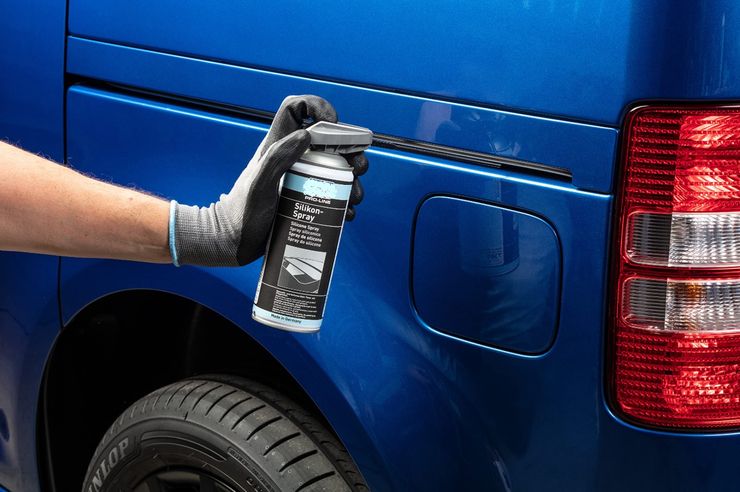Silicone oil: what do experienced car owners use it with?
- October 28, 2023
- 0
A car has many mechanisms and devices that need to be lubricated according to the car manufacturer’s requirements. However, in addition to these, there are still a number
A car has many mechanisms and devices that need to be lubricated according to the car manufacturer’s requirements. However, in addition to these, there are still a number
Polymethylsiloxane, more commonly called “silicone oil,” is an organosilicon fluid. It is valuable because in addition to its high lubricating properties, it is chemically very inert, virtually odorless and colorless. It is usually recommended to use it in a car to prevent ice formation. In all kinds of “sprayers” designed to treat the mechanisms of door handles and seals, the main ingredient is “silicone grease”.
In fact, it has many more applications in a vehicle. The most unexpected of them (for the vast majority of car owners) is the ability to temporarily solve electrical problems under the hood. For example, if it is difficult to start the engine, it may be useful to treat the battery terminals with silicone. If it is no longer brand new and is even covered in dust and dirt, its power may not be enough to start the engine with confidence. Due to the fact that parasitic currents often flow through the dirt layer on the battery and discharge it.
Silicone oil is a dielectric. By spraying the terminals with it, we electrically isolate them from each other and save a considerable amount of electricity. If you suspect that there is a current leak in high-voltage wires or a possible ignition coil, silicone oil is also used.
Treating the problem area of the electrical circuit with this dielectric will stop this mess. At least for a while. It is also useful to treat the creaking plastic decorative panel with silicone. Or better said: the place where it interacts with adjacent parts.
A door that creaks when opening and closing is no less legitimate prey for silicone spray. The pedal assembly of an old car can also make unpleasant noises during use. In this case, the seals and joints present in the design must be “sprinkled” with silicone oil. The problem will most likely go away, and for a long time. The seat glides sometimes start to “squeak” unpleasantly during the adjustment process. They are also lubricated with “silicone” to eliminate unpleasant noises.
Note that “silicone” is an excellent tool to extend the life of all kinds of rubber products. Some experienced car owners are not lazy and from time to time treat the anthers of drives and suspension connections, as well as pipes under the hood. Polymethylsiloxane restores the elasticity of rubber products for a long time. This means they do not crack and are less torn.

Polymethylsiloxane, more commonly called “silicone oil,” is an organosilicon fluid. It is valuable because in addition to its high lubricating properties, it is chemically very inert, virtually odorless and colorless. It is usually recommended to use it in a car to prevent ice formation. In all kinds of “sprayers” designed to treat the mechanisms of door handles and seals, the main ingredient is “silicone grease”.
In fact, it has many more applications in a vehicle. The most unexpected of them (for the vast majority of car owners) is the ability to temporarily solve electrical problems under the hood. For example, if it is difficult to start the engine, it may be useful to treat the battery terminals with silicone. If it is no longer brand new and is even covered in dust and dirt, its power may not be enough to start the engine with confidence. Due to the fact that parasitic currents often flow through the dirt layer on the battery and discharge it.
Silicone oil is a dielectric. By spraying the terminals with it, we electrically isolate them from each other and save a considerable amount of electricity. If you suspect that there is a current leak in high-voltage wires or a possible ignition coil, silicone oil is also used.
Treating the problem area of the electrical circuit with this dielectric will stop this mess. At least for a while. It is also useful to treat the creaking plastic decorative panel with silicone. Or better said: the place where it interacts with adjacent parts.
A door that creaks when opening and closing is no less legitimate prey for silicone spray. The pedal assembly of an old car can also make unpleasant noises during use. In this case, the seals and joints present in the design must be “sprinkled” with silicone oil. The problem will most likely go away, and for a long time. The seat glides sometimes start to “squeak” unpleasantly during the adjustment process. They are also lubricated with “silicone” to eliminate unpleasant noises.
Note that “silicone” is an excellent tool to extend the life of all kinds of rubber products. Some experienced car owners are not lazy and from time to time treat the anthers of drives and suspension connections, as well as pipes under the hood. Polymethylsiloxane restores the elasticity of rubber products for a long time. This means they do not crack and are less torn.
Source: Avto Vzglyad
Donald Salinas is an experienced automobile journalist and writer for Div Bracket. He brings his readers the latest news and developments from the world of automobiles, offering a unique and knowledgeable perspective on the latest trends and innovations in the automotive industry.